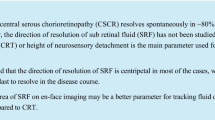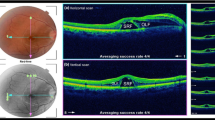Abstract
Background
To study the demography, various morphological patterns and fluid dynamics of the smokestack leak by fluorescein angiography (FA) in central serous chorioretinopathy (CSC).
Methods
Part I (clinical): review of the medical records and angiographic documents of 69 consecutive cases of CSC with smokestack leak. Part II (experimental): documentation of the movement of various concentrations of fluorescein dye due to convection currents in a laboratory model that roughly represents a closed chamber similar to that of CSC in human eyes.
Results
The clinical study (Part I) revealed that 14.40% of 479 consecutive cases had smokestack leak, of which 70% occurred in first acute episode (p-value: <0.001), 27.14% in acute recurrent episodes (50% fresh leak) and 2.85% in chronic stage. Patients were predominantly male (84.05%) with a median age of 34.00 ± 8.14 years. The median symptom duration excluding the chronic cases was 15 ± 34.28 days. This type of leak was mostly (48.57%) seen in medium-sized CSC, and the majority were in the parafoveal superonasal quadrant (31.42%). The ascending type of leak was predominant (94.28%). In four eyes, an atypical pattern and in two eyes more than one smokestack leak were seen within the same detached area. The experimental study (Part II) demonstrated that fluid containing a low concentration of fluorescein ascended due to convection currents, whereas highly concentrated dye descended.
Conclusions
The clinical study revealed smokestack leaks to be significantly more common in a primary acute episode, and they usually develop in the early part of the acute phase of the disease (average duration 15 ± 34.28 days). Rarely, this type of leak can occur in the chronic stage, and multiple leaks may develop in the same detached space. The various patterns of dye movement due to convection currents in the experimental model resembled the dye movement in certain cases of CSC of the present series. The experimental study also hinted at the probability of drainage of unbound fluorescein molecules along with protein-laden heavy fluid in downward spread of the leak.










Similar content being viewed by others
References
Novotny HR, Alvis DL (1961) A method of photographing fluorescence in circulating blood in the human retina. Circulation 24:82–86
Ciardella AP, Guyer DR, Spitznas M, Yannuzzi LA (2001) Central serous chorioretinopathy. In: Ryan S (ed) Retina, 3rd ed., Vol 2. Mosby, St Louis, pp 1153–1181
Shimizu K, Tobari I (1971) Central serous retinopathy dynamics of subretinal fluid. Mod Probl Ophthalmol 9:152–157
Wessing R (1973) Changing concept of central serous chorioretinopathy and its treatment. Trans Am Acad Ophthalmol Otolaryngol 77:275–280
Burton TC (1972) Central Serous Chorioretinopathy. In: Blodi E (ed) Current concepts in ophthalmology. CV Mosby, St Louis, pp 1–28
Yannuzzi LA, Schatz H, Gitter KA (1979) Central Serous Chorioretinopathy. In: The Macula: A Comprehensive Text and Atlas. Williams & Wilkins, Baltimore MD, pp 145–165
Friberg TR, Campagna J (1989) Central chorioretinopathy: an analysis of the clinical morphology using image-processing techniques. Graefes Arch Clin Exp Ophthalmol 227:201–205
Bujarborua D, Nagpal PN (2005) CSR: idiopathic central serous chorioretinopathy. Jaypee Brothers, New Delhi, pp 36–51
How ACSW, Koh AHC (2006) Angiographic characteristics of acute central serous chorioretinopathy in an Asian Population. Ann Acad Med Singapore 35:77–79
Spitznas M, Huke J (1987) Number, shape, and topography of leakage points in acute type I central serous retinopathy. Graefes Arch Clin Exp Ophthalmol 225:438–440
Bujarborua D (2001) Long-term follow-up of idiopathic central serous chorioretinopathy without laser. Acta Ophthalmol Scan 79:417–421
Gass JMD (1967) Pathogenesis of disciform detachment of the neuroepithelium. II. Idiopathic central serous chorioretinopathy. Am J Ophthalmol 63:587–615
Burke JM, McKay BS, Jaffe GJ (1991) Retinal pigment epithelial cells of the posterior pole have fewer Na/K adenosine triphosphatage pumps than peripheral cells. Invest Ophthalmol Vis Sci 32:2042–2046
Spaide RF, Goldbaum M, Wong DWK, Jang KC, Iida T (2003) Serous detachment of the retina. Retina 23(6):820–846
Guyer DR, Yannuzzi LA, Slakter JS, Sorenson JA, Ho A, Orlock D (1994) Digital indocyanine green videoangiography of central serous chorioretinopathy. Arch Ophthalmol 112:1057–1062
Iida T, Kishi S, Hagimura N, Shimizu K (1999) Persistent and bilateral choroidal vascular abnormalities in central serous chorioretinopathy. Retina 19:508–512
Kitaya N, Nagaoka T, Hikichi T, Sugawara R, Fukui K, Ishiko S, Yoshida A (2003) Features of abnormal choroidal circulation in central serous chorioretinopathy. Br J Ophthalmol 87:709–712
Prunte C, Flammer J (1996) Choroidal capillary and venous congestion in central serous chorioretinopathy. Am J Ophthalmol 121:26–34
Piccolino FC, Borgia L (1994) Central serous chorioretinopathy and indocyanine green angiography. Retina 14:231–242
Scheider A, Nasemann JE, Lund OE (1993) Fluorescein and indocyanine green angiographies of central serous chorioretinopathy by scanning laser ophthalmoscopy. Am J Ophthalmol 115:50–56
Hirami Y, Tsujikawa A, Sasahara M, Gotoh N, Tamura H, Otani A, Mandui M, Yoshimura N (2007) Alteration of retinal pigment epithelium in central serous chorioretinopathy. Clin Experiment Ophthalmol 35(3):225–230
Kim RY, Yao XY, Marmor MF (1993) Oxygen dependency of retinal adhesion. Invest Ophthalmol Vis Sci 34:2074–2078
Bailey TA, Kanuga N, Romero IA, Greenwood J, Luthert PJ, Cheetham ME (2004) Oxidative stress affects the junctional integrity of retinal pigment epithelial cells. Invest Ophthalmol Vis Sci 45(2):675–684
Friedman E (1977) Central serous chorioretinopathy: pathogenesis and treatment. In: Brockhurst RJ, Boruchoff SA, Hutchinson BT, Lessell S (eds) Controversy in ophthalmology. WB Saunders, Philadelphia, pp 706–709
Gaudric A, Sterkers M, Coscas G (1987) Retinal detachment after choroidal ischemia. Am J Ophthalmol 104:364–372
Eandi CM, Ober M, Iranmanesh R, Peiretti E, Yannuzzi LA (2005) Acute central serous chorioretinopathy and fundus autofluorescence. Retina 25:989–993
Gass JDM (1977) Idiopathic central serous choroidopathy (ICSC). In: Brockhurst RJ, Boruchoff SA, Hutchinson BT, Lessell S (eds) Controversy in ophthalmology. WB Saunders, Philadelphia, pp 710–714
Goldstein BG, Pavan PR (1987) “Blow-outs” in the retinal pigment epithelium. Br J Ophthalmol 71:678–681
Carvalho-Recchia CA, Yannuzzi LA, Negrao S, Spaide RF, Freud KB, Rodriguez-Coleman H, Lenharo M, Iida T (2002) Corticosteroids and central serous chorioretinopathy. Ophthalmology 109:1834–1837
Hee NR, Puliafito CA, Wong C, Reichel E, Duker JS, Schuman JS, Swanson EA, Fujimoto JG (1995) Optical coherence tomography of central serous chorioretinopathy. Am J Ophthalmol 120(1):65–74
Iida T, Hagimura N, Sato T, Kishi S (2000) Evaluation of central serous chorioretinopathy with optical coherence tomography. Am J Ophthalmol 129(1):16–20
Moschos M, Brouzas D, Koutsandrea C, Stefanos B, Loukianou H, Papantinosio F, Moschos M (2007) Assessment of central serous chorioretinopathy by optical coherence tomography and multifocal electroretinography. Ophthalmologica 221(5):292–298
Ojima Y, Hangai M, Sasahara M, Gotog N, Inone R, Yasuno Y, Makita S, Yatagai T, Tsujikawa A, Yoshimura N (2007) Three-dimensional imaging of the foveal photoreceptor layer in central serous chorioretinopathy using high-speed optical coherence tomography. Ophthalmology 114(12):2197–2207
Takeuchi A, Kricorian G, Marmor MF (1995) Albumin movement out of the subretinal space after experimental retinal detachment. Invest Ophthalmol Vis Sci 36:1298–1305
Negi A, Marmor MF (1984) Experimental serous retinal detachment and focal pigment epithelial damage. Arch Ophthalmol 102:445–449
Asayama K (1976) In vivo study on the absorption of the subretinal fluid.2. Studies on an absorption of tracers injected between the sensory retina and the pigment epithelium layer. Acta Soc Ophthalmol Jpn 80:598–607
Gibbs–Donnan effect. http://en.wikipedia.org/wiki/Gibbs–Donnan effect (accessed April 16, 2008).
Garrett AB (1987) Colloid. The new book of popular science, Vol. 3. Grolier International Inc., pp 107–117
Schatz H (1989) Fluorescein angiography: basic principles and interpretation. In: Ryan SJ (ed) Retina, vol 2. The C.V. Mosby Company, St. Louis, pp 3–77
Marmor MF (1988) New hypotheses on the pathogenesis and treatment of serous retinal detachment. Graefes Arch Clin Exp Ophthalmol 226:548–552
Shukla D, Aiello LP, Kolluru C, Baddela S, Jager RD, Kim R. (2008) Relation of optical coherence tomography and unusual leakage pattern in central serous chorioretinopathy. Eye 22(4):592–596.58
Fujimoto H, Gomi F, Wakabayashi T, Sawa M, Tsukawa M, Yano Y (2008) Morphologic changes in acute central serous chorioretinopathy evaluated by fourier-domain optical coherence tomography. Ophthalmology 115(9):1494–1500
Convection. http://en.wikipedia.org/wiki/Convection (accessed April 16,2008).
Rayleigh–Bénard Convection. http://physics.ucsd.edu/was-daedalus/convection/rb.html (accessed April 16, 2008).
Rayleigh number. http://en.wikipedia.org/wiki/Rayleigh_Number (accessed April 16, 2008).
Yoshioka H, Katsume Y, Akune H (1982) Experimental central serous chorioretinopathy in monkey eyes: fluorescein angiographic findings. Ophthalmologica, Basel 185:168–178
Watanabe G, Iida T, Takahashi K, Sato T, Kishi S, Shimizu M (2001) Clinical characteristics of bullous retinal detachment manifesting inferiorly-directed smokestack phenomenon. Jap J Ophthalmol 55(6):1217–1220 (English abstract)
Acknowledgements
We are grateful to Dr Nazimul Hussain, Dr Samrat Chatterjee, Dr Wartikar Sharang, Dr Geetanjali Bori, Dr Ankur Rahman, Dr. Aditya Sharma and Dr Kamal Nagpal for their help in various stages of this study, and indebted to Mr Omana Kuttan for his technical assistance.
Author information
Authors and Affiliations
Corresponding author
Additional information
Financial support None.
Rights and permissions
About this article
Cite this article
Bujarborua, D., Nagpal, P.N. & Deka, M. Smokestack leak in central serous chorioretinopathy. Graefes Arch Clin Exp Ophthalmol 248, 339–351 (2010). https://doi.org/10.1007/s00417-009-1212-5
Received:
Accepted:
Published:
Issue Date:
DOI: https://doi.org/10.1007/s00417-009-1212-5




